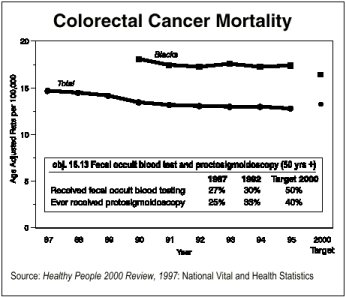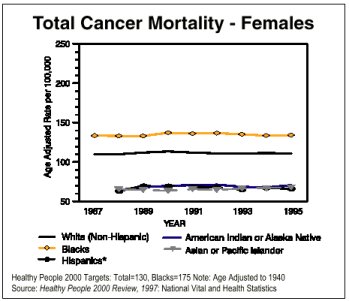|

The Assistant Secretary for Health and Surgeon General chaired the third review of
progress on the Healthy People 2000 cancer objectives. The lead agency for this priority
area, the National Cancer Institute of the National Institutes of Health, organized the
progress review around three themes: declines in incidence and mortality, disparities, and
behavioral indicators. The discussion focused on a selected number of the 17 objectives in
the Healthy People 2000 cancer priority area.
16.1 In 1995, the 2000 target for total cancer death rates was achieved with 130
reported cases per 100,000. Black cancer death rates have decreased from the 1990 baseline
of 182 per 100,000 to 172 in 1995, thereby exceeding the 2000 target of 175 per 100,000.
16.4 The proportion of black and Hispanic females who die of cervical cancer
continues to rise. In 1995, data from the National Vital Statistics System indicated that
5.2 black females per 100,000 died from cervical cancer, as did 3.1 per 100,000 Hispanic
females. The cervical cancer death rate for all females was 2.5 per 100,000 in 1995.
16.5 The age-adjusted death rate for colorectal cancer decreased from a 1987
baseline of 14.7 per 100,000 to 12.8 in 1995, thus exceeding the 2000 target of 13.2 per
100,000.
16.6 The prevalence of cigarette smoking among people 18 years and over
decreased slightly from the 1987 baseline of 29 percent to 25 percent in 1995. The year
2000 target is 15 percent. Data from the 1995 National Health Interview Survey showed that
smoking rates among blacks, Hispanics, and American Indians/Alaska Natives 18 years and
older decreased to 26 percent, 18 percent, and 35 percent respectively. The prevalence of
smoking among South East Asian males decreased sharply from the 1984-88 baseline of 55
percent to 35 percent (in Vietnamese males only) in 1990 . However, smoking prevalence
among black adolescents has begun to rise.
16.8 There has been an increase in the average daily intake of vegetables,
fruits, and grain products. In 1996, people 2 years and older consumed an average of 4.7
servings of vegetables, moving toward the year 2000 target. The average daily intake of
6.9 servings of grain products has exceeded the year 2000’s target 6.0 servings.
16.9 There is no update for this objective on actions to limit sun exposure. The
1992 baselines for people 18 years and over are as follows: those very likely to limit sun
exposure, 32 percent; use sun screen, 29 percent; wear protective clothing, 28 percent.
The year 2000 target is for 60 percent of people to take action to limit sun exposure.
16.10 This objective measures the proportion of primary care providers who
routinely counsel patients about tobacco use cessation, diet modification, and cancer
screening recommendations. There has been an increase in tobacco use cessation and
counseling by clinicians from a 1986 baseline of 52 percent to 96 percent in 1989. The
year 2000 target is 75 percent.
16.11 In 1994, 56 percent of all females aged 50 and older had received a
clinical breast examination and mammogram. For black females, the rate was 56 percent,
while for Hispanic and low-income females the rates were 50 percent and 38 percent,
respectively. The 2000 target is 60 percent for all population groups.
16.12 In 1994, 94 percent of females reported having received a pap test
compared to the 1987 baseline of 88 percent. The proportion of Hispanic females aged 18
years and over who have ever received a pap test has increased from 75 percent in 1987 to
91 percent in 1994. The year 2000 target is 95 percent
16.13 In 1992, 30 percent of people 50 years of age and over reported having
received a fecal occult blood test within the preceding two years, as compared to the
1987 baseline of 27 percent. Thirty-three percent of people 50 years and older reported
having received a proctosigmoidoscopy, compared to a 1987 baseline of 25 percent. The year
2000 targets are 50 percent and 40 percent, respectively.
16.17 Oral cancer deaths among males 45-74 years of age decreased from a 1987
baseline of 13.6 per 100,000 to 11.0 in 1995. Oral cancer deaths also decreased among
females from a 1987 baseline of 4.8 per 100,000 to 3.9 in 1995. Although rates for blacks
are also decreasing, oral cancer has a greater impact on black males; 1995 data from the
National Vital Statistics System indicated that the oral cancer death rate for black males
was 23.4 per 100,000 (baseline 29.4 in 1990). Oral cancer death rates for black females
decreased from a 1990 baseline of 6.9 per 100,000 to 6.4 per 100,000 in 1995.
H I G H L I G H T S
Cancer Incidence and Mortality, 1973-1995: A Report Card for the United States indicates
that incidence and death rates for all cancers combined and for most of the top 10 cancer
sites declined between 1990 and 1995, reversing an almost 20-year trend of increasing
cancer cases and deaths.
Six years after its inception in 1992, the Breast Cancer Prevention Trial shows a 45
percent reduction in breast cancer incidence among the high-risk participants who took
tamoxifen (Nolvadex®).
Eliminating disparities in cancer screening and management is one of the six goals in the
DHHS Initiative to Eliminate Racial and Ethnic Health Disparities .
  
F O L L O W- U P
The progress review concluded with a summary of action items:
- Develop a data collection strategy to further understand factors that put certain racial
and ethnic groups at higher risk for cancer. This strategy would include the collection of
data on behavioral and cultural issues, as well as surveillance on access to preventive
services and the full continuum of care.
- In seeking a more balanced approach to research, increase the proportion of investment
in behavioral health communications and applied research.
- Develop strategies for increasing participation of racial and ethnic population groups
in clinical trials.
- Increase investment for research to establish the value of interventions.
- As cancer objectives for Healthy People 2010 are developed, assure appropriate attention
to children’s health issues and environmental risks.
P A R T I C I P A N T S
Agency for Healthcare Research and Quality (AHRQ)
American Cancer Society
Baylor College of Medicine
Centers for Disease Control and Prevention
Food and Drug Administration
Harlem Hospital Center (NY)
Health Care Financing Administration
Health Resources and Services Administration
National Cancer Institute
North Carolina State Department of Natural Resources
National Coalition of Hispanic Health and
Human Services Organizations
Ohio State University
Office of Disease Prevention and Health Promotion
Office of Minority Health
Office on Women’s Health
Pan American Health Organization
Substance Abuse and Mental Health Services Administration
University of Oklahoma
University of Kentucky
Healthy People 2000 and 2010
Office of Disease Prevention and
Health Promotion
738G Humphrey Building
200 Independence Avenue, Washington, D.C. 20201
(202) 401-7736
Fax: (202) 205-9478
http://www.health.gov/healthypeople

David Satcher, M.D., Ph.D.
Assistant Secretary for Health and
Surgeon General
|